This Post is a continuation for the Significance of Winter Pruning Post, offering a brief insight into the evolution of Arterra’s innovative pruning technique….
Winter pruning resets the vine, both in terms of defining the upcoming seasons potential crop load, but also the intended density of the vine, and facilitating the vine’s growth habit. Over my 22 seasons growing grapes in Fauquier County, Virginia, i have tried to optimize quality, while stabilizing yields. In the past, i found each pruning technique had its good and bad aspects. I’ve evolved into my third approach to pruning, one that does mirror some “pre-industrial” techniques, but overall in our application to Virginia is inherently a new approach. I’m very excited, because i have not yet discovered a down side to my new system.
In order to understand what i am currently doing, we need to revisit the predecessor techniques… But simply put, in recent history amidst “industrial era” viticulture – the vine has always been trained with a vertical trunk (or two), then fixed horizontally along a “fruiting wire”, and the current seasons growth ascends as parallel & vertical canes from the horizontal fruiting wire infrastructure.
Virginia started with something called “Cordon-Trained & Spur Pruned”… It copied what was prominent in California – which was developed in California to facilitate mechanization…. we’ll explain shortly what this is, but i wasn’t fond of it…. Meanwhile, I had seen some photographs in trade magazines of vines in the vineyards of top Chateau in France, and i replicated those…. This in general is called ‘Cane Pruning’, often in the ‘Old-World’ it is called Guyot (either single guyot if it has one arm going one direction from the trunk, or double guyot if it has two arms going in opposite directions from the trunk).
Here is what a cane pruned vine looks like….
Cane Pruned Vine
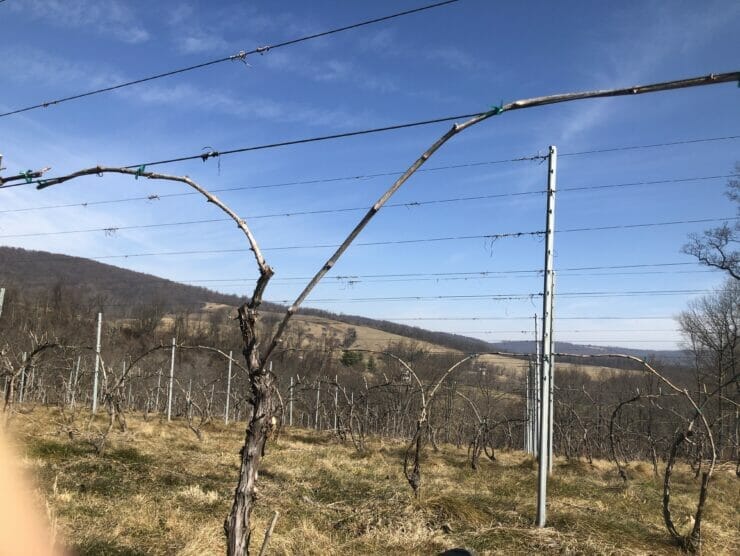
….The vine ultimately has everything from the previous year removed except the two central canes, which are selected and tied to the fruiting wire in winter. The buds along those canes will be the growing points for the upcoming seasons canopy and crop. This was a graceful process, facilitated ‘self-regulation’ of density by the vine, was extremely efficient come time for shoot thinning in the spring, and kept the vine healthy by minimizing ‘old wood’. I loved it. But as the climate changed, different issues developed within different varietals. Sometimes the central canes were weak and there were not ideal renewal options to select and lay on the wire; or growth would be weak midway along the cane leaving a gap of productivity; or frost would have a bigger impact on so few buds; or bud necrosis would damage the upcoming crop due to winter volatility. The issues combined became significant enough to instigate the need for change….
Cordon-Trained and Spur Pruned
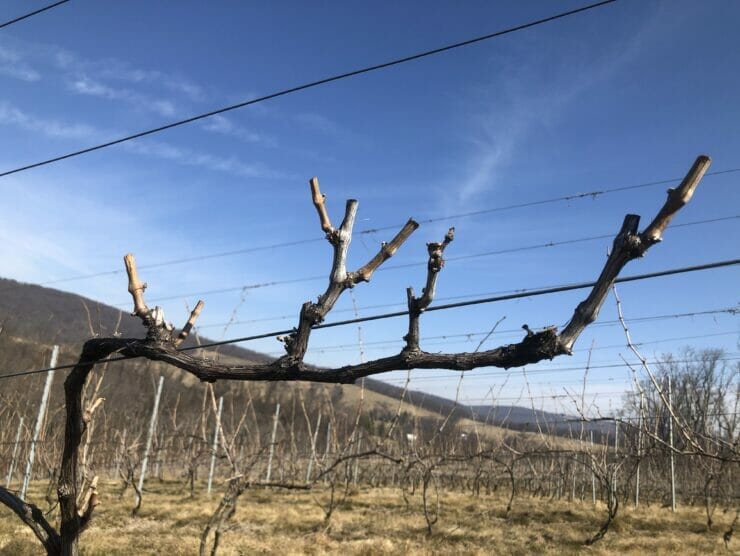
In pursuit of stabilizing productivity in the face of frost and winter volatility, i converted to “Cordon-Trained & Spur Pruned”, not because it in & of itself solved any of these problems, but because Virginians had evolved a very intelligent adaptation that did solve the problems. Effectively “Cordon-Trained & Spur Pruned” is continuing the trunk up & out horizontally along the fruiting wire as permanent infrastructure called a ‘Cordon’, as shown here….
….The piece Virginians added, is that instead of just cutting down to these “spurs” (growing points) in the winter once unwanted locations removed; instead these spurs were left with very tall canes/spurs of 12 to 24 inches, so that apical dominance would first open up the highest buds in early spring, while maintaining extended dormancy on the lowest buds. A final cut to the basal buds that were actually intended for the growing season occurs immediately as those top buds open: cut too early and the frost & volatility avoidance is lost, cut too late and the crop is reduced as the vine aborts fruit on the basal buds which are assimilated a ‘perceived’ trunk. Effectively the upside here is protecting the buds we want as to the foundation of the coming seasons crop. The down side is that the increased ‘woody’ infrastructure retains disease inoculum and also fosters chronic trunk diseases which lead to decline; as well as having spurs over time evolve into less-than-ideal locations and distribution. This system works, but i didn’t like it. The energetics felt clunky and burdensome; the vines felt weighted and sluggish. It was ugly.
The AH-HA Moment!!
In quest for a better way, my brain made a connection…. I have always been fascinated by the goblet style vineyards of the ‘Old World’…. If you are inspired by wine, i’m sure you’ve seen the un-trellised vineyards of Spain, and some of the oldest California vineyards. Multiple trunks in a goblet formation. It’s also called sprawl…. it kinda like a bunch of spiders in the fields. But it can’t work in the mid-atlantic, as these vines focus fruit towards the vine center, and trap dampness & humidity. BUT – if we took the multiple trunks that form the goblet, and applied them in linear fashion to a trellis, we adapt this ‘pre-industrial’ approach to our Virginia conditions.
Ultimately we are growing 3 to 4 trunks per vine, and originating fewer shoots from the “head” of each trunk, as opposed to so many more spurs on a horizontal cordon. It can be called “head trained & spur pruned”. This is simple to train young vines into, but it is a challenge to convert older vines. We have focused on fostering growth points lower on the vine, to establish new trunks. These multiple trunks replace the horizontal growth – eliminating horizontal growth. Each trunk has a split at the top to retain two spurs, each spur will produce 2 shoots in the upcoming season, resulting in 4 shoots per trunk/head. The following winter those 4 shoots will be re-thinned to 2 spurs.
Pic of a head with 4 shoots from the previous season
Previous Season Head with 4 Shoots
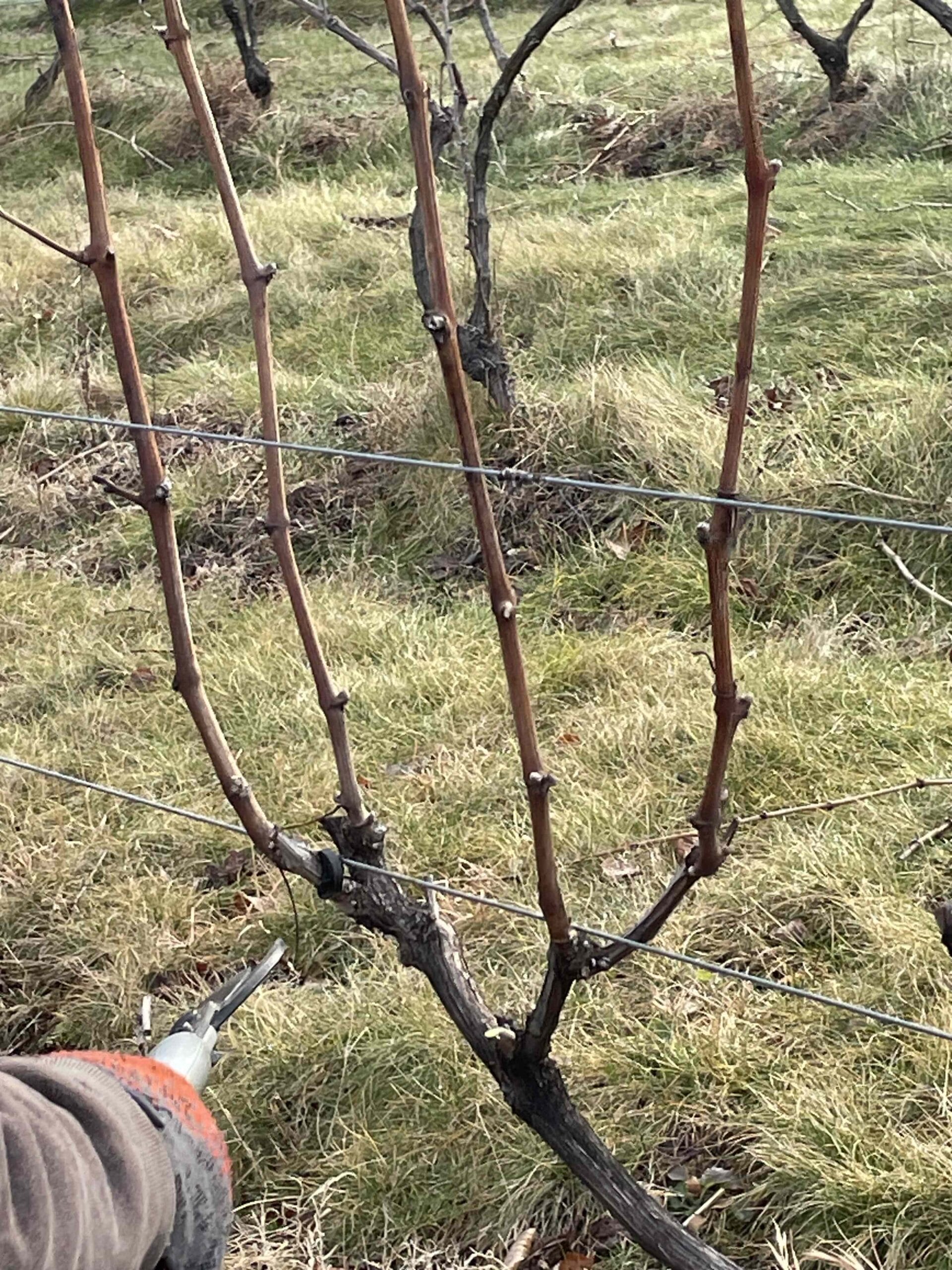
Same Head Thinned back to 2 Spurs for Upcoming Season.
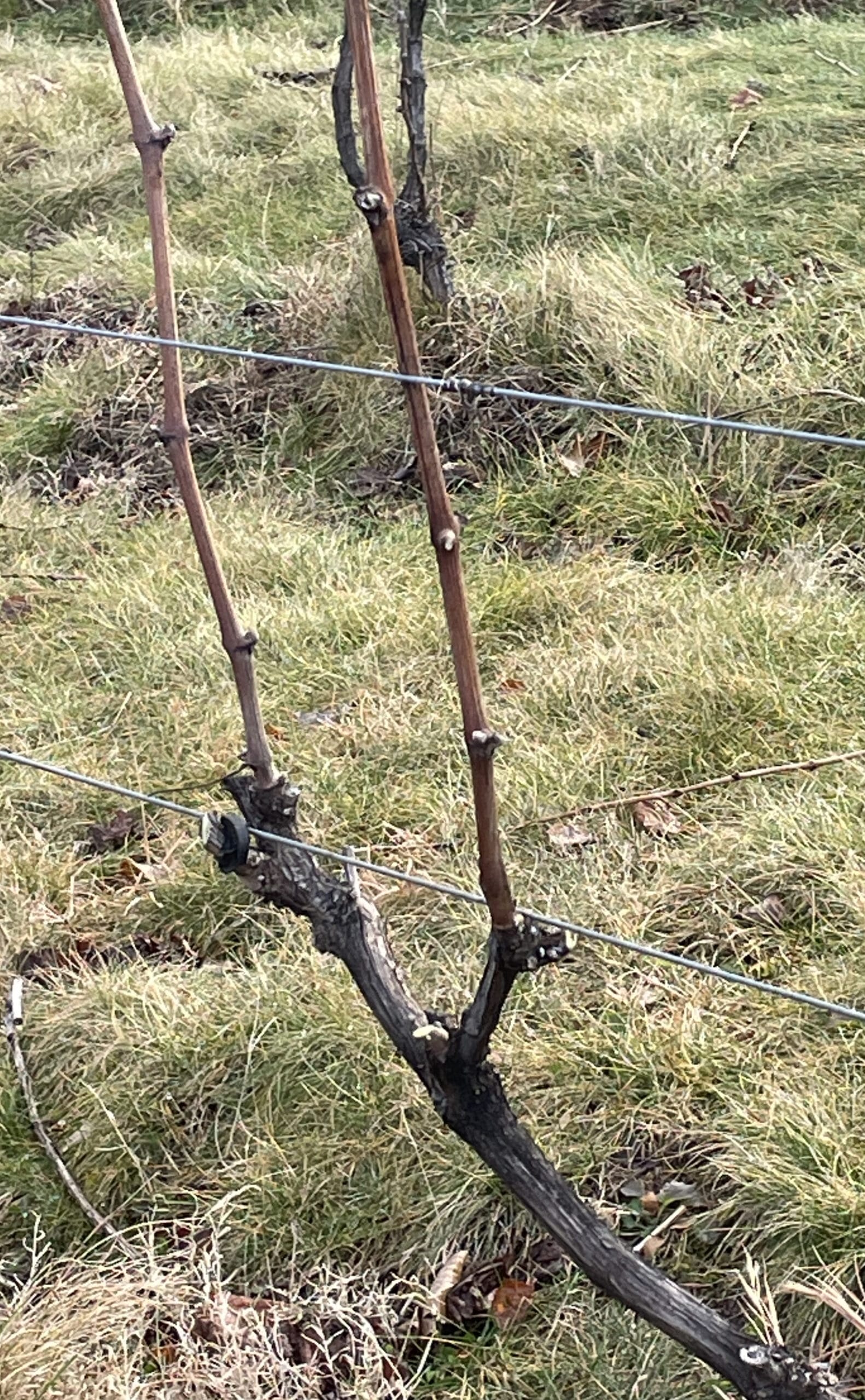
Pic of a finished pruned vine - awaiting the shortening of the spurs as spring growth starts.
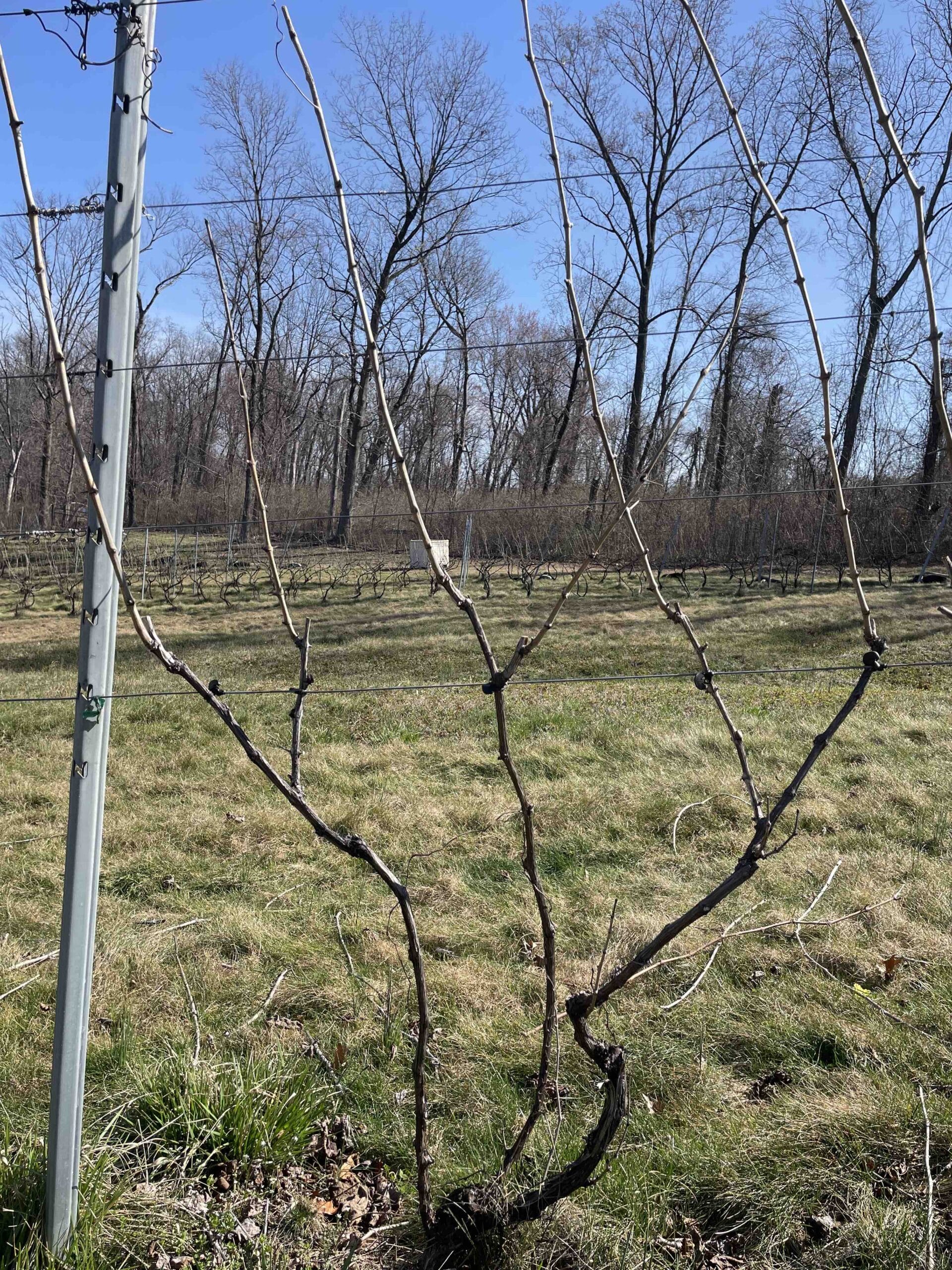
The Fan
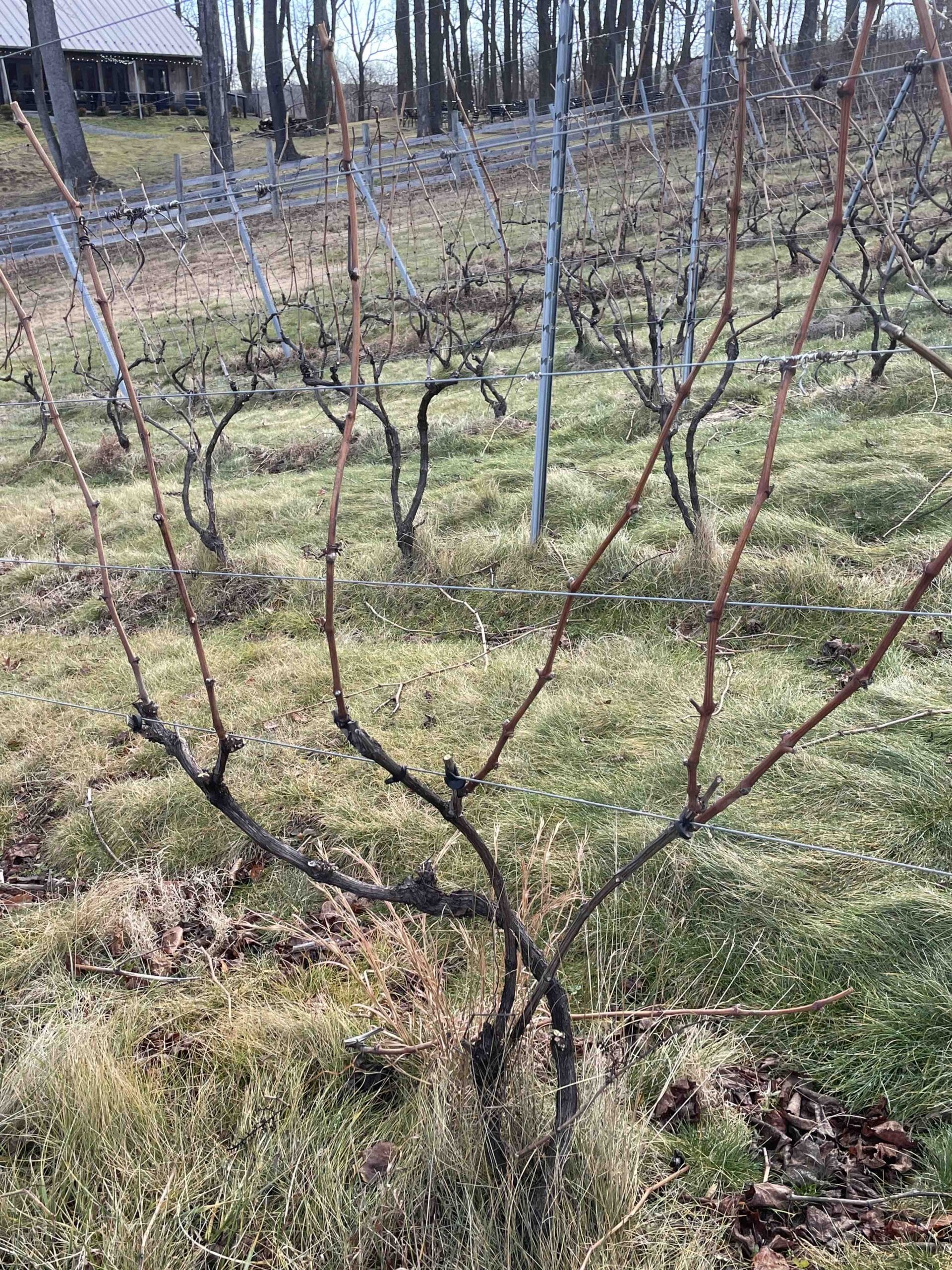
In this system we have all the upsides: spacing & delayed dormancy to protect the crop, & less “old wood”. I don’t see any of the downsides. And best yet – the vines are happy. This is a vertical oriented growth habit, which perfectly mirrors how vines grow in nature. We no longer have a vine growing up, then horizontal, the up again. Instead we have a lovely upward growth and energetic through spring, and a graceful downward energetic flow during fall & ripening.
It does not have a specific name yet – i don’t know if it ever will…. My buddies joking called it the ‘Murray Sprawl”. I think of it as a fan, since the base of the vine fans into multiple trunks, each of which fan into multiple spurs, each of which fan into multiple shoots – reminiscent of asian fans – which are graceful and beautiful.
I’m super excited to have a pruning system that makes sense, has no down-side, and inherently facilitates the vines natural growth habit, expressing grace and beauty.


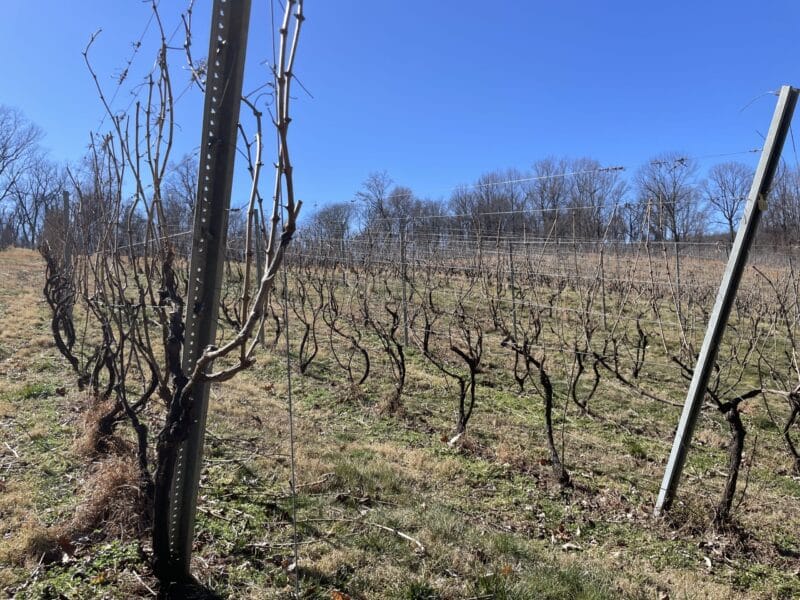
Not having any background in how to prune vines, your explanation made a lot of sense. Hope your approach continues to have success!